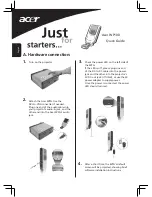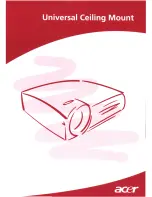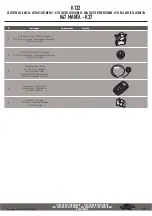
5
6. Installation
METHOD 1. HORIZONTAL INSTALLATION
1. Excavate a hole or trench a few centimeters deeper than the depth at which the sensor
is to be installed.
2. At the installation depth, shave off some soil from the vertical soil face exposing
undisturbed soil.
3. Insert the sensor into the undisturbed soil face until the entire sensor is inserted. The
tip of each prong has been sharpened to make it easier to push the sensor into the soil.
Be careful with the sharp tips!
4. Backfill the trench taking care to pack the soil back to natural bulk density around the
sensor body of the 5TE.
METHOD 2. VERTICAL INSTALLATION
1. Auger a 3-in hole to the depth at which the sensor is to be installed.
2. Insert the sensor into the undisturbed soil at the bottom of the auger hole using a hand
or any other implement that will guide the sensor into the soil at the bottom of the hole.
Many people have used a simple piece of PVC pipe with a notch cut in the end for the
sensor to sit in, with the sensor cable routed inside the pipe.
3. After inserting the sensor, remove the installation device and backfill the hole taking
care to pack the soil back to natural bulk density while not damaging the black
overmolding of the sensor and the sensor cable in the process.
Note: The installation method is from page 7 of 20435_5TE_Manual_Web.pdf.
7. Important Maintenance Instruction
Your device is a product of superior design and craftsmanship and should be used with care. The following suggestions will help you use the warranty
service effectively.
• Keep the equipment dry. Rain, moisture, and various liquids or moisture may contain minerals that can corrode electronic circuits. In case the device
is wet, please dry it completely.
• Do not use or store in dusty or dirty areas. This can damage its detachable parts and electronic components.
• Do not store in excessive heat. High temperatures can shorten the life of electronic devices, destroy batteries, and deform or melt some plastic parts.
• Do not store in a cold place. Otherwise, when the temperature rises to normal temperature, moisture will form inside, which will destroy the board.
• Do not throw, knock or shake the device. Rough handling of equipment can destroy internal circuit boards and delicate structures.
• Do not wash with strong chemicals, detergents or strong detergents.
• Do not apply with paint. Smudges can block debris in detachable parts and affect normal operation.
• Do not throw the battery into a fire to prevent the battery from exploding. Damaged batteries may also explode.
All of the above suggestions apply equally to your device, battery and accessories. If any device is not working properly.
Please take it to the nearest authorized service facility for repair.
























